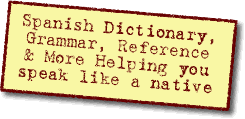Ask a Question(Create a thread) |
|
|||||||
Vió or vio?Grammar questions– conjugations, verb tenses, adverbs, adjectives, word order, syntax, etc. |
 |
|
|
Thread Tools |
|
#1
|
|||
|
|||
|
Vió or vio?
Hola a todos,
Estoy un poquito confundido. ¿Se usa un acento con el pretérito del verbo ver? Lo he visto con el acento y sin el acento también.
__________________
Corrijan mis errores, por favor. |
|
Get rid of these ads by registering for a free Tomísimo account.
|
|
#5
|
||||
|
||||
|
Las palabras de una sola sílaba (pie, fe, vio, fui, fue...) no se acentúan, excepto cuando su significado puede confundirse con el de otra palabra. (La regla parece haber cambiado recientemente, pero no estoy actualizada).
 Dé (subjuntivo de dar) ≠ de (preposición) Sí (afirmación) ≠ si (condicional) Dí (imperativo de decir) ≠ di (pasado de dar) Mí (pronombre) ≠ mi (adjetivo posesivo) Tú (pronombre) ≠ tu (adjetivo posesivo) Él (pronombre) ≠ el (artículo) Más (adición) ≠ mas (conjunción ≈ pero) ...
__________________
♪ ♫ ♪ Ain't it wonderful to be alive when the Rock'n'Roll plays... ♪ ♫ ♪ |
|
#7
|
||||
|
||||
|
No. (but "mas" without á... más = plus)
__________________
Please, don't hesitate to correct my English. 'Time is a sort of river of passing events, and strong is its current; no sooner is a thing brought to sight than it is swept by and another takes its place, and this too will be swept away.' M.A.
|
|
#10
|
||||
|
||||
|
From The Oxford English Dictionary...
a. The diacritic mark ˜ placed in Spanish above the letter n to indicate the mouillé or palatalized sound /ɲ/ , as in señor /sɛɲor/ . Also, the mark placed in Portuguese above the letters a and o to indicate nasalization. Used similarly in systems of phonetic transcription. Orig. the mouillé sound was written nn, as in the parallel ll; the tilde is an abbreviated form of the second n. There is a paragraph 'b.' but it defines the use of the tilde in mathematics. Last edited by Sancho Panther; February 05, 2011 at 10:55 AM. |
|
#11
|
||||
|
||||
|
Yes, but unfortunately, you are looking in the wrong dictionary, because the sentence was in Spanish. Try the RAE, which apart from the definition you give, also provides:
tilde. Signo ortográfico auxiliar con el que, según determinadas reglas, se representa en la escritura el acento prosódico (→</SPAN> acento, 1); por ello, la tilde recibe también los nombres de acento gráfico u ortográfico. En español consiste en una rayita oblicua que, colocada sobre una vocal, indica que la sílaba de la que forma parte es tónica. La tilde debe trazarse siempre de derecha a izquierda, esto es, como acento agudo (´), y no de izquierda a derecha (`), trazo que corresponde al acento grave, que carece de uso en español: camión, no  camiòn. camiòn. 
|
|
#12
|
||||
|
||||
|
You may also want to read this article. The Spanish name virgulilla is mentioned as the name for the mark above the 'ñ'. There are a few humoristic names for it, too - cola de cerdo/chancho and gusanillo are popular.
|
 |
«
Previous Thread
|
Next Thread
»
| Link to this thread | |
|
|
|||||||
 Similar Threads
Similar Threads
|
||||
| Thread | Thread Starter | Forum | Replies | Last Post |
| Jamás me vio nadie llorar así | bobjenkins | Translations | 2 | December 15, 2009 04:43 PM |
All times are GMT -6. The time now is 02:09 AM.







